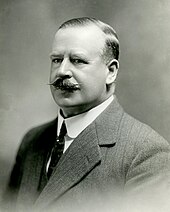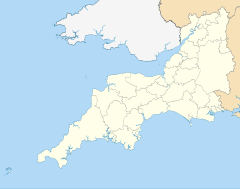SSRotorua(1910)
 Rotorua
| |
| History | |
|---|---|
| Name | Rotorua |
| Namesake | Rotorua |
| Owner |
|
| Operator |
|
| Port of registry | Plymouth |
| Route |
|
| Builder | Wm Denny & Bros,Dumbarton |
| Cost | £172,483 |
| Yard number | 915 |
| Launched | 9 July 1910 |
| Completed | 8 October 1910 |
| Identification |
|
| Fate | Sunk by torpedo, 22 March 1917 |
| General characteristics | |
| Type | Ocean liner |
| Tonnage | 11,130GRT,7,094NRT,10,600DWT |
| Length | 484.2 ft (147.6 m) |
| Beam | 62.3 ft (19.0 m) |
| Draught | 29.4 ft (9.0 m) |
| Depth | 41.1 ft (12.5 m) |
| Decks | 3 |
| Installed power | 605NHP,8,631ihp |
| Propulsion |
|
| Speed | 15 knots (28 km/h) |
| Capacity |
|
| Crew | 144 |
| Armament | (asDEMS): 1 ×4.7-inch gun |
| Notes | sister ships:Ruahine,Remuera |
SSRotoruawas aNew Zealand Shipping Companysteamocean linerandrefrigerated cargo shipthat was built inScotlandin 1910 and sunk by aU-boatin 1917.
She was not the only NZ Shipping Co ship to be calledRotorua.There was also a ship that was launched in 1911 asShropshirefor theFederal Steam Navigation Company,transferred to the NZ Shipping Co fleet in 1936 and renamedRotorua.She was sunk by a U-boat in 1940.[1]
Building[edit]
The NZ Shipping Co orderedRotoruaas asister shipforRuahine,whichWilliam Denny and BrothersofDumbartonhad launched in 1909. Mrs George T Haycraft, wife of one of the NZ Shipping Co's directors, launchedRotoruaon 9 July 1910.[2]The ship was completed on 8 October. She was 484.2 ft (147.6 m) long, her beam was 62.3 ft (19.0 m) and hertonnageswere 11,130GRTand 7,094NRT.Rotoruawas slightly larger thanRuahine,and at the time was the largest ship yet built in Dumbarton.[2][3]
WhereasRuahinehad twoscrews,each driven by atriple-expansion steam engine,Rotoruahad three screws, with Denny's applying the same engine layout that they had pioneered in the refrigeratedcargo linerOtakithat they had built for the NZ Shipping Co and launched in 1908. A triple-expansion engine drove herport and starboardscrews. Exhaust steam from the low-pressure cylinder of each of those engines powered aParsonsturbine that drove her centre shaft.[2]Between them the two triple-expansion engines developed 5,350ihpand the turbine developed another 3,281 ihp.[4]Together the three engines were rated at 605NHP.[3]On hersea trialsRotoruaachieved a top speed of 15.77 knots (29.21 km/h).[5]
Rotorua's holds had 299,540 cubic feet (8,482 m3) ofrefrigerated cargospace, primarily for frozenmutton,and 194,180 cubic feet (5,499 m3) of space for non-refrigerated cargo.[6]She hadderricksable to lift up to 25tons.[2]
Rotoruahad berths for 580 passengers: 52 first class, 88 second class, 440 third class.[6]She carried 14 lifeboats and twowhaleboats.[7]Because her beam was 2 feet (0.6 m) broader thanRuahine's,Rotorua's public saloons were slightly broader. She had a children's nursery, her first class lounge was decorated inAdam style,and her first class dining saloon had apipe organ.[2]
The NZ Shipping Co registeredRotoruaatPlymouth.Her UKofficial numberwas 124587 and hercode letterswere HRSG.[8]
Peacetime service[edit]

In October 1910Rotoruawas put on public display in theRoyal Albert Dock, London.[9]She began her maiden voyage fromLondonon 27 October and called atPlymouthtwo days later.[6]She calledLas Palmason 3 November,Cape Townon 18 November[10]andHobarton 6 December.[11]Her arrival inWellingtonon 11 December was front-page news.[12]She completed the voyage from England in 42 days and 20 hours, and crossing theTasman Seashe averaged 14 knots (26 km/h).[10]
Early in 1911 theIrish Parliamentary PartypoliticiansJohn Donovan,Richard HazletonandWilliam Redmondsailed onRotoruato Tasmania and New Zealand to seek support forIrish home rule.[13][14]
Rotoruafirst visitedAucklandon 18 May 1911. Again she was put on public display.[15]
On 31 May 1911 Denny's launchedRemuera,[16]another sister ship forRuahineandRotorua.Remuerawas slightly larger than her sisters, and so supplantedRotoruaas the largest ship built at Dumbarton and the largest ship in the NZ Shipping Company's fleet.[17]
Early in 1913 the New Zealand Government experimented by shipping 3,000 eggs to England aboardRotorua.The eggs were kept at 45 °F (7 °C) throughout the 16,000-nautical-mile (30,000 km) voyage. When they arrived in London six weeks later they were reported to be "in splendid condition".[18]
By 1914Rotoruawas equipped forwireless telegraphy.TheMarconi Companyoperated her equipment on the standard 300 and 600 metre wavelengths. Hercall signwas MKE.[19]
First World War[edit]
When theFirst World Warbegan on 28 July 1914,Rotoruawas in theAtlanticon her way to England. About a week later she reached the neutral port ofSanta Cruz de Tenerife,where she was instructed to stay for safety. After some days she was instructed to proceed, with all her lights blacked out. She reached Plymouth and London without incident.[20]
On her return voyage to New Zealand in October 1914,Rotoruadid not call at Cape Town but continued to Hobart without stopping.[21]On another voyage to New Zealand in July and August 1915,Rotoruadid not call at Santa Cruz de Tenerife.[22]Both omissions were for wartime safety.
During the warRotoruawasdefensively armedwith one4.7-inch gunon herpoop deck.[7]
By March 1915Rotoruathe marking "F 529" had been applied to both sides ofRotoruaamidships. This was an identification mark, like apennant number.The "F" indicated that she carried food, and therefore should be prioritised over other cargo ships forpilotingandbunkering.[23]
In February 1916Rotoruarepatriated 203 members of theNew Zealand Expeditionary Forcewho had been discharged from hospitals in the UK.[24]The soldiers sharedRotorua's third class accommodation with 130 civilian passengers. Third class aboardRotoruaincluded access to her forwardwell deck,but she not long after she left England some of the civilians complained about the soldiers. Thereafter the soldiers were barred from that part of the ship until about a week before she reached Auckland. This was not how they expected civilians to treat them after they had been in combat and wounded.[25]
In July 1916Rotoruarepatriated another 56 invalided New Zealand soldiers.[26]
ThePanama Canalhad been opened in August 1914, and on 3 May 1916 the Union Company announced that it would routeRotoruaandRemueravia the canal instead of via Cape Town.[27]However, a month later the company announced thatRotoruawas going via Cape Town and Hobart instead.[28]

In September or October 1916Rotoruaused the Panama Canal for the first time. She was en route to London, and her passengers includedNew Zealand Prime MinisterWilliam Masseyand hisMinister of FinanceJoseph Ward.[29]Ward was impressed with the canal's economic potential for New Zealand, and predicted "It is going to be a greater highway for commerce than theSuez Canal".[30]
On 24 December 1916 theUnion Steamship CompanylinerMaitairan aground on a reef offRarotonga.She was carrying 43 passengers and 900 tons of cargo,[31]including more than 1,400 bags of mail bound for New Zealand. Much of the mail was from troops serving overseas.[32]Rotoruawas diverted to assist. She reached Rarotonga on 31 December, embarkedMaitai's passengers and loaded her mails.[33]
Rotoruahad been bound for Wellington,[33]but withMaitai's mails and passengers she diverted to Auckland, where she arrived on the evening of 8 January.[34]Rotorua's passengers again included wounded soldiers being repatriated from France.[35]
On 19–20 JanuaryRotoruawas inPort Chalmerswhen two of her stokers went absent without leave, went toDunedinand enlisted in the armed forces under false names. The pair were caught, and on 22 January pleaded guilty at DunedinPolice Court.[36]
Loss and wreck[edit]
On 3 FebruaryRotorualeft Wellington with a full cargo of frozen food and other produce. She called atNewport News, Virginia[37]and in March she reached Plymouth, where her 264 passengers disembarked. She then left Plymouth for London,[38]but on 22 March 1917SMUC-17sank her by torpedo inLyme Bayabout 24 nautical miles (44 km) east ofStart Point, Devon.[37]As the crew were abandoning ship one of her stewards fell overboard.[39]He was the only fatality.[40]
In her short career of seven yearsRotoruahad completed 13 round trips between England and New Zealand.[38]Her loss was a double blow for the NZ Shipping Co, as on 10 March the Germanmerchant raiderSMSMöwehad sunkOtakiina gun battle.[41]Five ofOtaki's crew had been killed, and the survivors were captured as prisoners of war.
Rotorua's wreck lies with a list to port at a depth of 144 to 213 feet (44 to 65 m).[39][42]She is now arecreational dive siteforwreck diving.Divers have recovered herbell.[7]
References[edit]
- ^Helgason, Guðmundur."Rotorua".Uboat.net.Retrieved20 December2020.
- ^abcde"Rotorua launched".The New Zealand Times.24 August 1910. p. 5.Retrieved20 December2020– via Papers Past.
- ^ab"Rotorua".Scottish Built Ships.Caledonian Maritime Research Trust.Retrieved20 December2020.
- ^"Rotorua (1910)"(.pdf).P&O Heritage.Retrieved4 February2021.
- ^"New Zealand liner".The New Zealand Times.24 November 1910. p. 2.Retrieved20 December2020– via Papers Past.
- ^abc"The new Rotorua".The New Zealand Times.8 December 1910. p. 3.Retrieved20 December2020– via Papers Past.
- ^abcLettens, Jan; Eekelers, Dirk; Chipchase, Nick; Allen, Tony."SS Rotorua [+1917]".Wrecksite.Retrieved20 December2020.
- ^Registrar General of Shipping and Seamen (1911).Mercantile Navy List.Board of Trade.p. 449.Retrieved19 January2021– via Crew List Index Project.
- ^"New steamer Rotorua".The New Zealand Times.1 December 1910. p. 3.Retrieved20 December2020– via Papers Past.
- ^ab"New steamer Rotorua".Auckland Star.12 December 1910. p. 8.Retrieved20 December2020– via Papers Past.
- ^"R.M.S. Rotorua".The Daily Post.3 December 1910. p. 3.Retrieved20 December2020– via Trove.
- ^"The steamer Rotorua".The New Zealand Times.12 December 1910. p. 1.Retrieved20 December2020– via Papers Past.
- ^"Greatest revolution since Cromwell".Auckland Star.26 April 1911. p. 5.Retrieved20 December2020– via Papers Past.
- ^"Irish envoys".The Northern Advocate.27 March 1911. p. 5.Retrieved20 December2020– via Papers Past.
- ^"A fine steamer".Auckland Star.18 May 1911. p. 5.Retrieved20 December2020– via Papers Past.
- ^"Remuerua".Scottish Built Ships.Caledonian Maritime Research Trust.Retrieved20 December2020.
- ^"Launch of the Remuera".Auckland Star.17 July 1911. p. 9.Retrieved20 December2020– via Papers Past.
- ^"New Zealand eggs".Taranaki Herald.14 March 1913. p. 7.Retrieved20 December2020– via Papers Past.
- ^The Marconi Press Agency Ltd 1914,p. 405.
- ^"The Rotorua's voyage".The Press.28 September 1914. p. 4.Retrieved20 December2020– via Papers Past.
- ^"(untitled)".The New Zealand Times.20 October 1914. p. 5.Retrieved20 December2020– via Papers Past.
- ^"(untitled)".TheTaihapeDaily Times.18 August 1915. p. 8.Retrieved20 December2020– via Papers Past.
- ^"(untitled)".Auckland Star.16 March 1915. p. 6.Retrieved20 December2020– via Papers Past.
- ^"Returned soldiers".The New Zealand Times.4 February 1916. p. 5.Retrieved20 December2020– via Papers Past.
- ^"Deck room on the Rotorua".The Evening Post.5 February 1916. p. 9.Retrieved20 December2020– via Papers Past.
- ^"Another hospital ship".Grey RiverArgus.21 July 1916. p. 3.Retrieved20 December2020– via Papers Past.
- ^"Via Panama Canal".The Evening Post.4 May 1916. p. 2.Retrieved20 December2020– via Papers Past.
- ^"The Rotorua's route".The New Zealand Herald.3 June 1916. p. 8.Retrieved20 December2020– via Papers Past.
- ^"New Zealand Ministers".The Poverty Bay Herald.20 October 1916. p. 3.Retrieved20 December2020– via Papers Past.
- ^"The Panama route".Hawera and Normanby Star.20 December 1916. p. 6.Retrieved20 December2020– via Papers Past.
- ^"Stranding of Maitai".The New Zealand Herald.30 December 1916. p. 8.Retrieved20 December2020– via Papers Past.
- ^"The mishap to the Maitai".The Press.1 January 1917. p. 7.Retrieved20 December2020– via Papers Past.
- ^ab"Maitai's position".The New Zealand Times.3 January 1917. p. 4.Retrieved20 December2020– via Papers Past.
- ^"Telegraphed movements".TheMarlborough Express.8 January 1917. p. 4.Retrieved20 December2020– via Papers Past.
- ^"Returned soldiers".The Southland Times.9 January 1917. p. 5.Retrieved20 December2020– via Papers Past.
- ^"City police court".TheOtago Daily Times.23 January 1917. p. 2.Retrieved20 December2020– via Papers Past.
- ^abHelgason, Guðmundur."Rotorua".Uboat.net.Retrieved20 December2020.
- ^ab"S.S. Rotorua sunk".The Sun.26 March 1917. p. 10.Retrieved20 December2020– via Papers Past.
- ^ab"Rotorua 1".Wrecks.Teign Diving Centre. 2019.Retrieved20 December2020.
- ^"Loss of Rotorua".The New Zealand Herald.27 March 1917. p. 4.Retrieved20 December2020– via Papers Past.
- ^"A double loss".The Auckland Star.1917. p. 6.Retrieved20 December2020– via Papers Past.
- ^"Rotorua".www.ukdiving.co.uk.Personal Print Ltd.Retrieved20 December2020.
Bibliography[edit]
- The Marconi Press Agency Ltd(1914).The Year Book of Wireless Telegraphy and Telephony.London: The Marconi Press Agency Ltd.
- Waters, Sydney D (1939).Clipper Ship to Motor Liner; the story of the New Zealand Shipping Company 1873–1939.London: TheNew Zealand Shipping CompanyLtd.
External links[edit]
- DrCharlesw (18 September 1911).SS Rotorua - New Zealand Shipping Company.YouTube.– video of a dive to the bow ofRotorua's wreck

